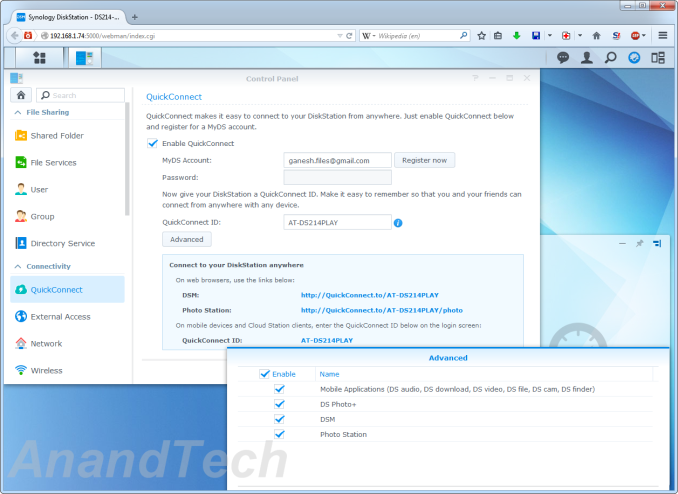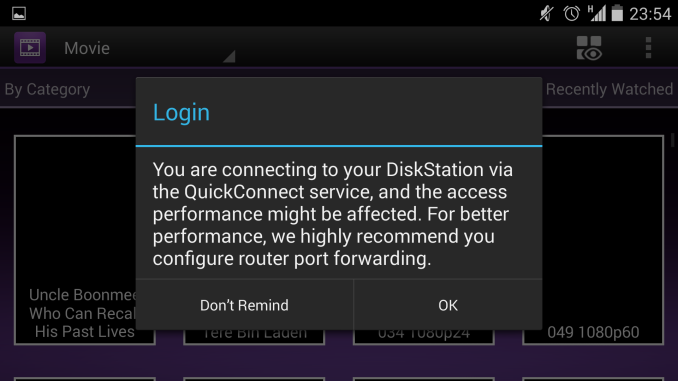Synology DS214play: Intel Evansport Almost Done Right
by Ganesh T S on May 20, 2014 3:00 PM ESTDSM 5.0: External Access
As mentioned in an earlier section, going through all the features of DSM 5.0 in detail would be beyond the scope of this review. However, the DS214play's claim to fame is its multimedia capabilities. It is only fair that we have a few sections devoted to the multimedia and external access (for multimedia streaming) features of the firmware. First, we take a look at the external access features of DSM 5.0.
A Synology NAS can be accessed from an external network through two different methods. In the first case (for users who don't want to be bothered with port forwarding on their routers), the connection is made through Synology's relay servers. Each NAS intended to be accessed in this way has to be provided with a unique QuickConnect ID (that is registered with Synology). Synology allows registration only with a valid MyDS account.
The QuickConnect settings can be found in the DSM interface under the Control Panel's Connectivity options. External access can be regulated on a per-service basis (in terms of access to just the mobile apps for multimedia streaming, or even NAS management using the DSM UI itself). Accessing a NAS from an external network through Synology's relay servers results in helpful cautionary messages about possible slowness (when using bandwidth-intensive apps such as DS Video).
Port forwarding settings can be accessed via the 'External Access' section right after the 'QuickConnect' settings in the Control Panel. Synology supports multiple DDNS services and also offers their own. Users who have configured QuickConnect already have a QuickConnect.to DDNS setup and don't need to add another. In order to configure port forwarding, the DSM mandates that the unit must be set to receive a static IP (i.e, DHCP disabled). In case the router supports UPnP, the DSM can automatically create the port forwarding rules and apply it. The sequence of steps is shown in the gallery below.
Home users often have data on their NAS that they might want to share with friends in a quick and easy manner. DSM makes this task very easy, provided QuickConnect (or some other DDNS) is already set up. The gallery below outlines the steps in generating a shareable link for any file on the NAS.
The link can be used to download the file without entering login credentials (that are otherwise necessary when accessing the NAS using QuickConnect) and the validity period can also be customized. The link can also be protected with a password. The only minor point of complaint here is the fact that the generated link has the local IP address in it. Usually, the links are shared with people outside the local network. It would be nice if the hardcoded IP were to be replaced with a link based on the QuickConnect ID (if one exists). Full folders can also be shared through this method. In that case, the web browser presents a File Station interface in the browser. For one or two files, using the relay servers works OK. However, when sharing full folders, it might be a better option to forward port 5000 in the router to the Synology NAS.
























45 Comments
View All Comments
toonvl - Tuesday, May 20, 2014 - link
For me it's hardware RAID and RAID expansion options. FreeNAS OS can help you build a custom NAS yourself, but cannot provide RAID expansion sadly enough.That's if you want RAID 5, 6 and the likes and have the option to add/exchange disks with different capacity etc.. But if you just want RAID 1 and stick to it, then you're probably better off with a micro-ATX rig and software RAID like you suggest.ZeDestructor - Tuesday, May 20, 2014 - link
All in all, I have been completely sold on ZFS, and have no plans to use anything else for a NAS or any other form of critical storage until btrfs (a GPL-compliant and even more powerful successor to ZFS) gets a stable release. Oh, and personally I wouldn't run FreeNAS: I'd run bare FreeBSD and set it up manually.PS: A nice article from arstechnica on ZFS (and CoW FS in general): http://arstechnica.com/information-technology/2014...
ZeDestructor - Tuesday, May 20, 2014 - link
Gah... most of my comment about ZFS got nuked.... And I can't be bothered to retype in all out, so here's the tl;dr edition (read the arstechnica article I linked for more detailed info):Compared to HW RAID controllers:
- RAID5/6: ZFS has RAIDZ1/2/3, for 1, 2 or 3 disks worth of redundancy, equivalent to RAID5/6/there is no equivalent to RAIDZ3 to my knowledge
- Add/exchange disks with different capacity: Done in ZFS by swapping each disk in a vdev (ZFS term more or less equivalent to arrays), then "resilvering" once all is done to increase it's size.
Features no HW RAID controller has (to my knowledge):
- Copy-on-Write (CoW): each update to a file is written as the difference to the original file. This allows for self-healing (damaged blocks are recovered using checksums and old data to regenerate current data) and snapshots (snapshots of the FS is a a state a a point in time). Snapshots make incremental backups trivial. In fact, quite a lot of people use snapshots to back up production databases instead of doing a traditional dump the DB to disk method.
All in all, I have been completely sold on ZFS, and have no plans to use anything else for a NAS or any other form of critical storage until btrfs (a GPL-compliant and even more powerful successor to ZFS) gets a stable release. Oh, and personally I wouldn't run FreeNAS: I'd run bare FreeBSD and set it up manually.
PS: A nice article from arstechnica on ZFS (and CoW FS in general): http://arstechnica.com/information-technology/2014...
toonvl - Wednesday, May 21, 2014 - link
thanks! I'll check this out. When I have a need for a next expansion I'm probably going to use this :)JeffS - Tuesday, May 20, 2014 - link
I've been using 2-drive NAS appliances (first Netgear and then Synology) for probably 6 or 7 years now. I've got above-average technical acumen, but with two little kids and a busy job, I don't have enough hours in the day right now to worry about reliable storage. These things are small enough to sit on a bookshelf, they run quietly with low power, and a red light starts flashing and a buzzer sounds when there's a problem. About a year ago, one of the drives in my RAID-1 died. I swapped in a spare and never missed a beat. It would have been divorce court for me if our 20,000 family photos went down the drain. Yes, I still run regular backups (again, one push of a button on the front panel with an external drive plugged in), but it's a huge relief knowing that the odds are low of drive failure taking down our storage system. I never get support calls from home asking why the storage system is offline.Having said all that, I just bought a $250 Dell mini tower server, and I plan to move to it as our storage array. I'll probably keep the Synology and set up automated backup. I'm now trying to find space in the wiring closet for the Dell, and it's not an 'appliance' like these NAS units are.
Basically, the NAS took away all of the thinking with regard to redundant, networked storage, and that allowed me to stop procrastinating and get everything centralized with RAID and backup. I've got a lot of hobbies, but our primary storage array shouldn't be one of them.
We do only need about 2 TB of storage, so we're probably the ideal customer for a unit like this.
bill.rookard - Tuesday, May 20, 2014 - link
Couldn't agree more. I picked up a very nice rackable case a while back, dropped a Gigabyte mATX board in with a dual core Phenom processor, a few GB of ram, and 5 WD drives with FreeNAS. With the exception of one RMA'd drive which failed after about 6 months, it's been absolutely rock solid for about 7 years now. Total cost on the entire build, including drives (5 x 2TB drives) was right around $800 (the drives alone were $600 at the time).While I certainly do appreciate having an easy setup for this type of unit (plug, configure, play), the limitations are just too restrictive (ie: either 4TB with redundancy or 8TB without - which is simply NOT a real choice). Yes, I'm certainly an edge case when it comes to this type of thing, but looking at any 5-bay devices (which would be my personal minimum), you're easily into near four digit costs and that's NOT including a drive.
ganeshts - Tuesday, May 20, 2014 - link
I used to think like you guys till very recently. However, in addition to some of the points mentioned by other readers, there are certain aspects that only these NAS vendors provide:1. Mobile app ecosystem - Creation of a mobile app (iOS / Android) which presents an easy and intuitive interface to your NAS's contents
2. Operation of relay service to access your NAS content from an external network without port forwarding
3. Automatic backup of data from mobile devices to the NAS
4. In the case of DS214play, a hardware accelerated transcode engine behind the media server feature.
For a non-tech savvy consumer, or even for a person who knows the internal details, but doesn't want to spend time configuring or building a NAS, the units supplied by these NAS vendors make a good choice.
ZeDestructor - Tuesday, May 20, 2014 - link
I'll consider buying them when they use Copy-on-Write filesystems, and come in sizes greater than 16bays for under 6k (a fully-built backblaze pod for 45 drives comes in around the 3k mark). I value data integrity more than any convenience, and as of now (to my knowledge), a CoW FS is the best thing you can get.If you are in contact with said companies, it would be nice if you could mention that to them... anyone who has encountered bit rot knows that RAID just isn't enough these days...
jamyryals - Tuesday, May 20, 2014 - link
Couldn't agree with you more Ganesh. I have a home built set up right now on an old tower. I've been running Plex/Cloud-backups for a while now, and the fact these standalone NAS boxes have native integration with little hassle is very attractive. In the future I will be buying a solution like this.Aikouka - Tuesday, May 20, 2014 - link
Does Plex (read: Plex's modified version of FFMPEG) work with Evansport yet? Last I checked a month or so ago, it doesn't, which means you do not get hardware transcoding with this device (or any other Evansport-based NAS).